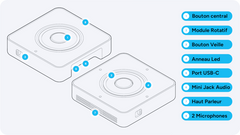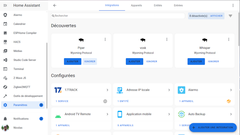Home Assistant Voice Preview Edition
By Nabu Casa
Home Assistant Voice Preview Edition controls your home automation system by voice
This page has been visited ... times

This is very interesting news for the opensource home automation community. Nabu casa, which needs no introduction, has released its first functional voice assistant, practical and for 100% local use.
No more online voice assistants that record all our words on external servers.
So I wonder if this product is functional and successful or if simply the year of the voice is not yet fully operational!
Most of us who are interested in voice assistants in local operation have already successfully tested installations on PC and often they are very successful, but when it comes to installing this on a raspberry pi it is a different story.
This QRcode allows you to read the full Home Assistant Voice manual you have the choice between scanning this QRcode from your smartphone or clicking directly on the link below.
Home Assistant has accustomed us in recent years to providing us with home automation boxes (Green and Yellow) in similar packaging with ecological appearances. What to say about the home assistant voice pe well at first glance not much:

The back of the box home assistant voice pe confirms that there is no USB-C cable or power supply provided, which is a bit surprising, but I would ignore this exception because we all have the means to power our home via USB-C except for Apple purists.

Let’s now take a look at the home assistant voice pe
Let’s start with the bottom side, we’ll find the product label, but if you look closely next to it there’s a notch that hides an i2C connector underneath, you can plug in all sorts of i2c micro-modules and enhance the home assistant voice pe
Let’s continue on the sides, we’ll find:

A small screenshot to give you an idea of the size of the home assistant voice pe

Let’s take a look at what’s hidden under the case. First thing to point out, we can see that everything is relatively well thought out, the screws are easily removed. The central button is included in the printed circuit, in short under the hood you will only find two independent parts, the circuit and the speaker nothing more.

Let’s move on to the various connectors found under the circuit:

Finally, I’ll give you some photos of the product as a whole.

| SoC | ESP32-S3 with 16MB FLASH storage 8MB PSRAM |
| Audio processing | XMOS XU316 |
| Power | USB-C, 5VDC, 2A |
| Radios | 2.4GHz Wi-Fi Bluetooth 5.0 Low Energy |
| Audio output | 3.5mm stereo line-out jack |
| Microphone and speaker | internal speaker Internal dual microphone array Mute switch |
| Operating conditions | Indoor use only 0°C to 30°C 32°F to 86°F |
| Humidity | non-condensing, Store in a dry and not too dusty environment, as this may damage the device |
| Dimensions and weight | 84 x 84 x 21 mm, 96g with box: 94x94x30 mm, 120g |
| Material | Polycarbonate plastic Colors: White and semi-transparent |

First of all, you will need to install the Esphome suite, nothing complicated!
Reminder: to make home assistant voice pe work, you will need to install the esphome library. Go to the addon-store by clicking on the link below:
Select and install ESPHome Device Compiler
home assistant voice pe is easy to use thanks to a great integration done by Mike Hanssen in esphome. I made a video retrospective of the features available in esphome.
The functions of home assistant voice pe are as follows:
There are 2 ways to quickly install home assistant voice pe and connect it to home assistant
If your box integrates a Bluetooth chip then I recommend this installation
This is a classic integration function that is often found on wifi module inclusions, but it is not the easiest, if your box is equipped with bluetooth I recommend the Bluetooth inclusion which is much simpler and faster.
To follow the configuration I will give you the details and home assistant has made an integration video
I haven’t encountered any real problems, it’s a little more finicky than Bluetooth integration
In Bluetooth it’s ultra simple you just have to go to Settings > Devices and services discovery tab and follow the animated gif below. Nothing could be simpler, you enter your wifi coordinates and that’s it. Warning only compatible with 2.4Ghz network

Last step add the Esphome discovered module, change the available wakeword (Okay Nabu, hey Jarvis or Hey Mycroft) and add a room if you want and that’s it.
For the French language Okay Nabu is in my opinion the most suitable and works very well.
A whole lot of options:
configure the LED lighting
As said above you can configure the LED directly in esphome but also physically below the animated gif

Mute the microphone
Either with the physical button on the side or through the esphome interface

I preferred to detail this process before integrating home assistant voice pe because I find it more relevant.
you will have to install and configure your system, start by installing:
Vosk or Rhassy-speech for the French voice sentence!
Home assistant advises you faster-whispervery good in English but for now very bad in French, it doesn’t matter Mike had developed the utility vosk which works pretty well for our French language and is currently developing the wyoming module Rhasspy-speech.
Mike has recently been developing rhasspy-speech which is another stt under development, it also offers you to modify the sentences and will allow you to refine your system but it must be said that the French sentence is already very complete.
Vosk has not been updated for over 5 months
Adds the repository Github Rhasspy for HAOS and you will have access to Vosk or Rhasspy-speech
Refresh the page F5, search vosk or rhasspy-speech and install it, then in the vosk configuration select the language fr and start the module.
Personally I use rhasspy-speech which should be the future for home-assistant voice.
for that you can use the Piper module that will do the trick. Go to the app store again:
and search for the Piper module, install it, in the Piper configuration select a custom voice I chose fr_FR-siwis-medium, it’s a female voice
PS: Rhasppy offers a utility to test the voice (upmc jessica in medium is great) but for now unusable in home assistant because she speaks in accelerated.
Here are the modules installed, now you have to add them to home assistant
For info: Faster-whisper is installed in the same way as the other two. Go to the module store, search for whisper, then install, then configure the language and start the whole thing.
Go to Settings > Device and service and add the Wyoming protocols

By default there is a voice assistant named Home Assistant and set up in English, I decide to reuse it and set it up in French.
Go to Settings > Voice Assistants > Add an assistant
Here are my settings for the French language
Home Assistant Voice Preview Edition is the first voice assistant designed from the ground up to work with Home Assistant. With its dual microphones and advanced audio processing, it can hear your commands and provide clear feedback through its speaker and LED ring. It was designed to blend in with your home decor, and its physical touch controls allow anyone to control the device intuitively. It was designed to be used with Home Assistant Assist, the privacy-focused voice assistant that lets you control Home Assistant using natural language. It is fully configurable, allowing you to do whatever you want with voice.
Let’s make open, local, private voice assistants a reality Your voice, your choice - We all deserve voice control that doesn’t collect our data or limit functionality. We’re rapidly advancing open, private voice for the home. Our vision is to match and then surpass other voice assistants. Join us in building Assist (or just come along) and preview the future of voice control in the home.
On-premises or Cloud If you have powerful hardware, run voice entirely on-premises or offload speech processing to our privacy-focused Home Assistant Cloud for fast performance.
Fully open and community-driven Fully open software, firmware, and hardware let you tailor it to your needs. With a dedicated community of developers customizing and adding features.
Built with room to grow Voice Preview Edition offers plenty of room to expand and tweak. Its specifications, especially its RAM and storage, have been chosen to give it room to add future features. It includes a Grove port for connecting sensors and a 3.5mm headphone jack for connecting external speakers. It is also easy to open.
This QRcode allows you to read the full Home Assistant Voice manual you have the choice between scanning this QRcode from your smartphone or clicking directly on the link below.
If you want to reset everything, don’t hesitate to do a factory reboot, to do this, press and hold the central button for 20 seconds

If you want instant commands and speed of action your home automation box must be quite robust below are the reactivity times between the request and the final response:
Depending on your system the latency delay is more or less long, I estimate that above 2 seconds the comfort is no longer the same. That doesn’t mean not to buy one if you have a box lacking in pep for voice assistance, because I think that in the future the stt and tts mechanisms will be lighter and lighter.
Here is a super product to control your home automation by voice and all locally (no external listening), it is a super well finished product with very well thought out functions. The whole voice assistance is not yet optimal, but I am convinced that the home assistant voice pe will fully satisfy you. In short, it is the voice assistant to have.
Copyright © 2025 Haade 🎉 by Nicoxygen
Comments